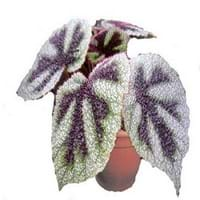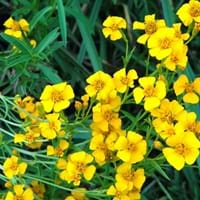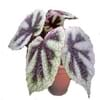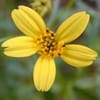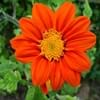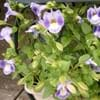Life Span
Perennial
Annual
Type
Herbaceous Perennial
Flowering Plants, Shrubs
Origin
Chile, Southeast Asia
Mexico, Central America
Types
Not Available
African or American Marigolds, French Marigolds, Mule Marigolds
Number of Varieties
Not Available
Habitat
Mountain forests, subtropical regions, Terrestrial
Roadsides, wastelands
USDA Hardiness Zone
11-12
9-11
AHS Heat Zone
12-5
12 - 1
Sunset Zone
H1, H2, 24
A1, A2, A3, H1, H2, 1a, 1b, 2a, 2b, 3a, 3b, 4, 5, 6, 7, 8, 9, 10, 11, 12, 13, 14, 15, 16, 17, 18, 19, 20, 21, 22, 23, 24
Habit
Clump-Forming
Upright/Erect
Flower Color
Dark Blue
Yellow, Orange, Gold, Ivory
Flower Color Modifier
Bicolor
Bicolor
Fruit Color
Tan
Not Available
Leaf Color in Spring
Light Green
Dark Green
Leaf Color in Summer
Light Green
Dark Green
Leaf Color in Fall
Light Green
Dark Green
Leaf Color in Winter
Light Green
Light Green
Plant Season
Fall, Spring, Summer
Summer, Fall
Sunlight
Full Sun
Full Sun
Growth Rate
Medium
Very Fast
Type of Soil
Loam, Sand
Clay, Loam, Sand
The pH of Soil
Acidic, Alkaline, Neutral
Neutral, Alkaline
Soil Drainage
Well drained
Well drained
Bloom Time
Early Summer, Late Spring
Indeterminate
Tolerances
Drought
Drought
Where to Plant?
Container, Ground, Pot
Container, Ground, Pot
How to Plant?
Seedlings, Stem Cutting
Seedlings
Plant Maintenance
Medium
Medium
Watering Requirements
Keep ground moist, Keep the Soil well drained, Requires regular watering
Allow to dry out slightly between watering
In Summer
Lots of watering
Lots of watering
In Spring
Moderate
Moderate
In Winter
Average Water
Average Water
Soil pH
Acidic, Alkaline, Neutral
Alkaline, Neutral
Soil Type
Loam, Sand
Clay, Loam, Sand
Soil Drainage Capacity
Well drained
Well drained
Sun Exposure
Full Sun
Full Sun
Pruning
Remove damaged leaves, Remove dead branches, Remove dead leaves
Prune ocassionally, Remove dead or diseased plant parts, Requires little pruning
Fertilizers
10-10-5, All-Purpose Liquid Fertilizer
All-Purpose Liquid Fertilizer
Pests and Diseases
Aphids, Mealy bugs, No serious insect or disease problems, Red spider mite
Alternaria Leaf Spot, Bacterial leaf spot, Damping-off, Gray mold, Powdery mildew, Root rot
Plant Tolerance
Drought
Drought
Flower Petal Number
Single
Single, Double, Semi-Double
Fragrant Bark/Stem
No
Yes
Foliage Texture
Fine
Coarse
Foliage Sheen
Matte
Matte
Attracts
Birds, Bugs, Insects, Not Available
Butterflies
Allergy
Unknown
Not Available
Aesthetic Uses
Bonsai, Borders, Landscape Designing, Mixed Border, Showy Purposes, Used for decorating walls, fences, gates, hedges, etc.
Showy Purposes
Beauty Benefits
Not Available
Not Available
Environmental Uses
Air purification
Air purification
Medicinal Uses
No Medicinal Use
Burns, constipation, Inflammation, Upset stomach, Wounds
Part of Plant Used
Not Available
Flowers, Seeds
Other Uses
Decoration Purposes, Showy Purposes, Used as Ornamental plant, Used for Landscaping
Can be made into a herbal tea, Decoration Purposes, Used As Food
Used As Indoor Plant
Yes
Yes
Used As Outdoor Plant
Yes
Yes
Garden Design
Bonsai, Container, Hanging Basket, Landscape
Flower borders
Botanical Name
Begonia masoniana
Tagetes lucida
Common Name
Angel's Wings, Butterfly Flower, Poor Man's Orchid
sweetscented marigold, Mexican marigold
In Hindi
iron cross begonia
sweetscented marigold
In German
Eisenkreuz Begonie
süß duftend Ringelblume
In French
croix de fer bégonia
Yauhtli
In Spanish
el hierro cruzado begonia
pericón, Santa María, yerbanís
In Greek
σταυρό μπιγκόνια σιδήρου
γλυκό άρωμα κατιφέ
In Portuguese
begônia cruz de ferro
Tarragon Mexicano
In Polish
Iron Cross begonia
słodkie pachnące nagietka
In Latin
ferrum crucem Begonia
sweetscented marigold
Phylum
Tracheophyta
Tracheophyta
Class
Magnoliopsida
Magnoliopsida
Order
Cucurbitales
Asterales
Family
Begoniaceae
Asteraceae
Clade
Angiosperms, Eudicots, Rosids
Not Available
Tribe
Not Available
Not Available
Subfamily
Not Available
Not Available
Season and Care of Begonia masoniana and Sweetscented Marigold
Season and care of Begonia masoniana and Sweetscented Marigold is important to know. While considering everything about Begonia masoniana and Sweetscented Marigold Care, growing season is an essential factor. Begonia masoniana season is Fall, Spring and Summer and Sweetscented Marigold season is Fall, Spring and Summer. The type of soil for Begonia masoniana is Loam, Sand and for Sweetscented Marigold is Clay, Loam, Sand while the PH of soil for Begonia masoniana is Acidic, Alkaline, Neutral and for Sweetscented Marigold is Neutral, Alkaline.
Begonia masoniana and Sweetscented Marigold Physical Information
Begonia masoniana and Sweetscented Marigold physical information is very important for comparison. Begonia masoniana height is 60.00 cm and width 30.00 cm whereas Sweetscented Marigold height is 60.00 cm and width 50.00 cm. The color specification of Begonia masoniana and Sweetscented Marigold are as follows:
Begonia masoniana flower color: Dark Blue
Begonia masoniana leaf color: Light Green
Sweetscented Marigold flower color: Yellow, Orange, Gold and Ivory
- Sweetscented Marigold leaf color: Dark Green
Care of Begonia masoniana and Sweetscented Marigold
Care of Begonia masoniana and Sweetscented Marigold include pruning, fertilizers, watering etc. Begonia masoniana pruning is done Remove damaged leaves, Remove dead branches and Remove dead leaves and Sweetscented Marigold pruning is done Prune ocassionally, Remove dead or diseased plant parts and Requires little pruning. In summer Begonia masoniana needs Lots of watering and in winter, it needs Average Water. Whereas, in summer Sweetscented Marigold needs Lots of watering and in winter, it needs Average Water.
